Cell Biology: Structure, Function, Adaptation, Transport & Emergencies
VerifiedAdded on 2023/06/15
|8
|2139
|195
Homework Assignment
AI Summary
This assignment delves into the fundamental aspects of human cell biology, covering cell structure, function, cellular respiration, and the requirements for cell survival. It defines cellular adaptation, detailing major types such as atrophy, metaplasia, hyperplasia, and hypertrophy. The solution further explores substance transport mechanisms, including simple diffusion, facilitated diffusion, osmosis, and hydrostatic force, specifying their requirements, examples, and direction of movement. It addresses environmental health problems arising from emergencies like diving decompression sickness and high altitude, outlining their effects and symptoms. The assignment also covers surgical and blunt trauma, anatomical terms, and physiological concepts like metabolism, respiration, and homeostasis. Furthermore, it discusses cellulitis, its causes, symptoms, and treatment, and concludes with an overview of paracetamol, its uses, mechanism of action, and contraindications. Desklib provides this and many other solved assignments to help students excel.
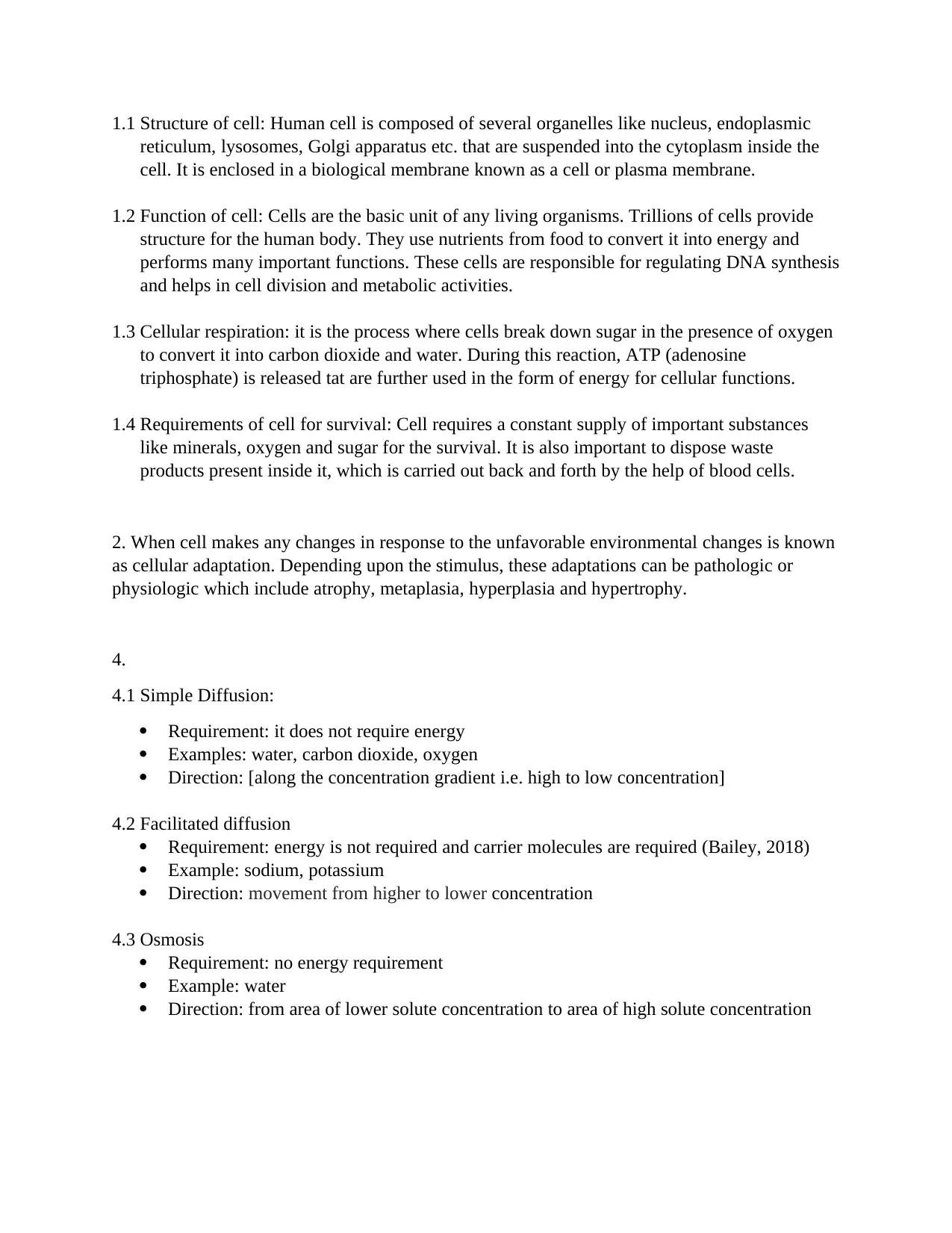
1.1 Structure of cell: Human cell is composed of several organelles like nucleus, endoplasmic
reticulum, lysosomes, Golgi apparatus etc. that are suspended into the cytoplasm inside the
cell. It is enclosed in a biological membrane known as a cell or plasma membrane.
1.2 Function of cell: Cells are the basic unit of any living organisms. Trillions of cells provide
structure for the human body. They use nutrients from food to convert it into energy and
performs many important functions. These cells are responsible for regulating DNA synthesis
and helps in cell division and metabolic activities.
1.3 Cellular respiration: it is the process where cells break down sugar in the presence of oxygen
to convert it into carbon dioxide and water. During this reaction, ATP (adenosine
triphosphate) is released tat are further used in the form of energy for cellular functions.
1.4 Requirements of cell for survival: Cell requires a constant supply of important substances
like minerals, oxygen and sugar for the survival. It is also important to dispose waste
products present inside it, which is carried out back and forth by the help of blood cells.
2. When cell makes any changes in response to the unfavorable environmental changes is known
as cellular adaptation. Depending upon the stimulus, these adaptations can be pathologic or
physiologic which include atrophy, metaplasia, hyperplasia and hypertrophy.
4.
4.1 Simple Diffusion:
Requirement: it does not require energy
Examples: water, carbon dioxide, oxygen
Direction: [along the concentration gradient i.e. high to low concentration]
4.2 Facilitated diffusion
Requirement: energy is not required and carrier molecules are required (Bailey, 2018)
Example: sodium, potassium
Direction: movement from higher to lower concentration
4.3 Osmosis
Requirement: no energy requirement
Example: water
Direction: from area of lower solute concentration to area of high solute concentration
reticulum, lysosomes, Golgi apparatus etc. that are suspended into the cytoplasm inside the
cell. It is enclosed in a biological membrane known as a cell or plasma membrane.
1.2 Function of cell: Cells are the basic unit of any living organisms. Trillions of cells provide
structure for the human body. They use nutrients from food to convert it into energy and
performs many important functions. These cells are responsible for regulating DNA synthesis
and helps in cell division and metabolic activities.
1.3 Cellular respiration: it is the process where cells break down sugar in the presence of oxygen
to convert it into carbon dioxide and water. During this reaction, ATP (adenosine
triphosphate) is released tat are further used in the form of energy for cellular functions.
1.4 Requirements of cell for survival: Cell requires a constant supply of important substances
like minerals, oxygen and sugar for the survival. It is also important to dispose waste
products present inside it, which is carried out back and forth by the help of blood cells.
2. When cell makes any changes in response to the unfavorable environmental changes is known
as cellular adaptation. Depending upon the stimulus, these adaptations can be pathologic or
physiologic which include atrophy, metaplasia, hyperplasia and hypertrophy.
4.
4.1 Simple Diffusion:
Requirement: it does not require energy
Examples: water, carbon dioxide, oxygen
Direction: [along the concentration gradient i.e. high to low concentration]
4.2 Facilitated diffusion
Requirement: energy is not required and carrier molecules are required (Bailey, 2018)
Example: sodium, potassium
Direction: movement from higher to lower concentration
4.3 Osmosis
Requirement: no energy requirement
Example: water
Direction: from area of lower solute concentration to area of high solute concentration
Paraphrase This Document
Need a fresh take? Get an instant paraphrase of this document with our AI Paraphraser
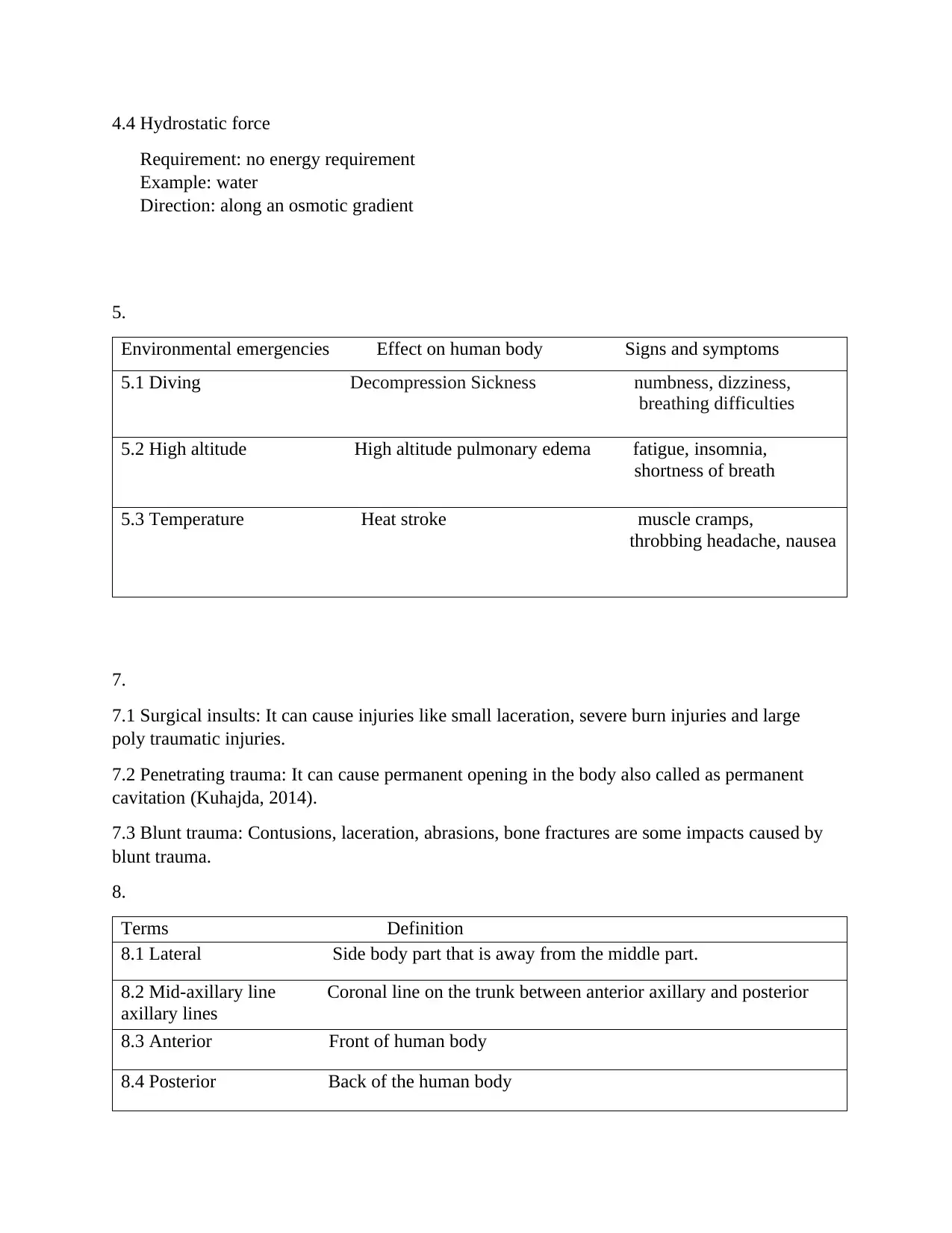
4.4 Hydrostatic force
Requirement: no energy requirement
Example: water
Direction: along an osmotic gradient
5.
Environmental emergencies Effect on human body Signs and symptoms
5.1 Diving Decompression Sickness numbness, dizziness,
breathing difficulties
5.2 High altitude High altitude pulmonary edema fatigue, insomnia,
shortness of breath
5.3 Temperature Heat stroke muscle cramps,
throbbing headache, nausea
7.
7.1 Surgical insults: It can cause injuries like small laceration, severe burn injuries and large
poly traumatic injuries.
7.2 Penetrating trauma: It can cause permanent opening in the body also called as permanent
cavitation (Kuhajda, 2014).
7.3 Blunt trauma: Contusions, laceration, abrasions, bone fractures are some impacts caused by
blunt trauma.
8.
Terms Definition
8.1 Lateral Side body part that is away from the middle part.
8.2 Mid-axillary line Coronal line on the trunk between anterior axillary and posterior
axillary lines
8.3 Anterior Front of human body
8.4 Posterior Back of the human body
Requirement: no energy requirement
Example: water
Direction: along an osmotic gradient
5.
Environmental emergencies Effect on human body Signs and symptoms
5.1 Diving Decompression Sickness numbness, dizziness,
breathing difficulties
5.2 High altitude High altitude pulmonary edema fatigue, insomnia,
shortness of breath
5.3 Temperature Heat stroke muscle cramps,
throbbing headache, nausea
7.
7.1 Surgical insults: It can cause injuries like small laceration, severe burn injuries and large
poly traumatic injuries.
7.2 Penetrating trauma: It can cause permanent opening in the body also called as permanent
cavitation (Kuhajda, 2014).
7.3 Blunt trauma: Contusions, laceration, abrasions, bone fractures are some impacts caused by
blunt trauma.
8.
Terms Definition
8.1 Lateral Side body part that is away from the middle part.
8.2 Mid-axillary line Coronal line on the trunk between anterior axillary and posterior
axillary lines
8.3 Anterior Front of human body
8.4 Posterior Back of the human body
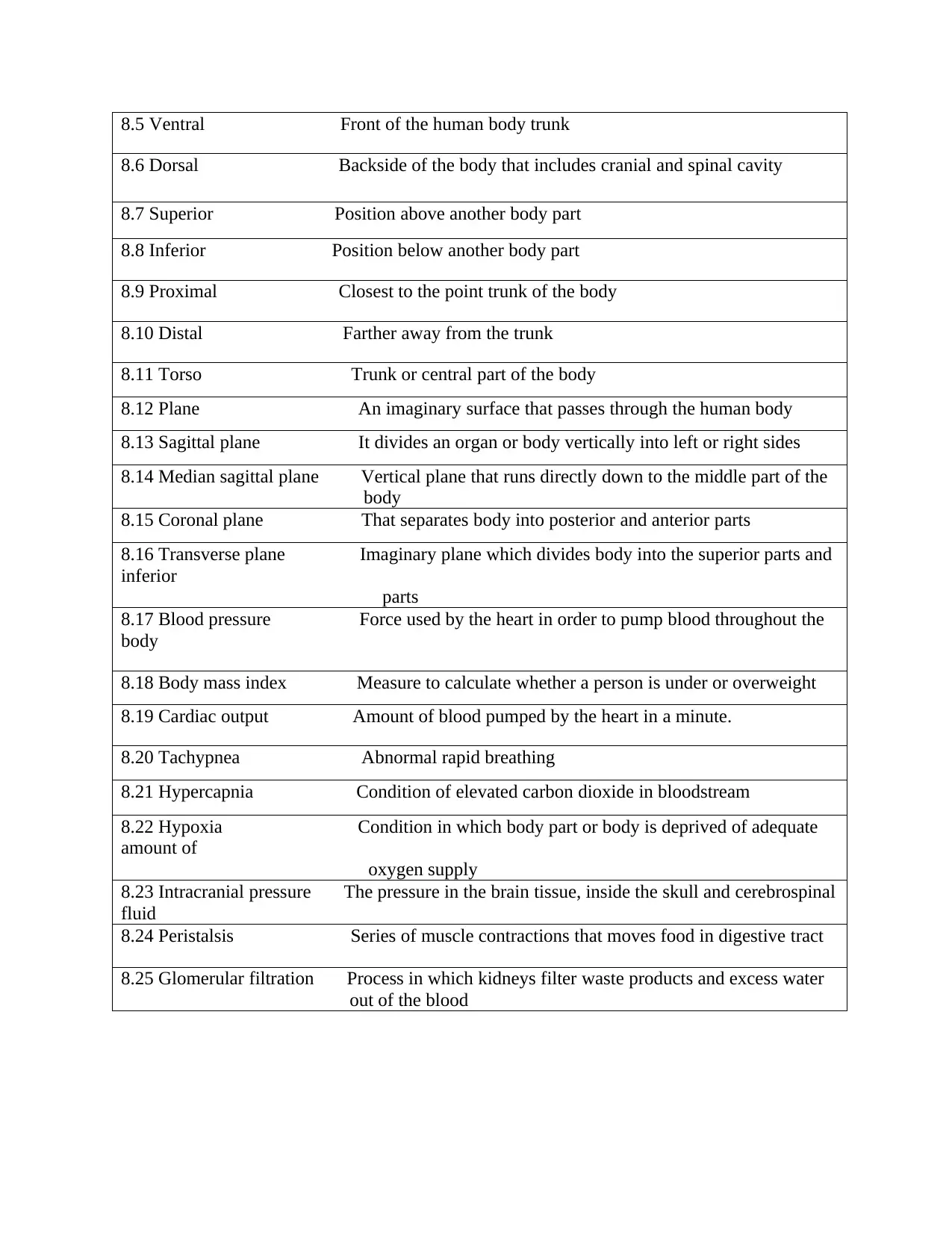
8.5 Ventral Front of the human body trunk
8.6 Dorsal Backside of the body that includes cranial and spinal cavity
8.7 Superior Position above another body part
8.8 Inferior Position below another body part
8.9 Proximal Closest to the point trunk of the body
8.10 Distal Farther away from the trunk
8.11 Torso Trunk or central part of the body
8.12 Plane An imaginary surface that passes through the human body
8.13 Sagittal plane It divides an organ or body vertically into left or right sides
8.14 Median sagittal plane Vertical plane that runs directly down to the middle part of the
body
8.15 Coronal plane That separates body into posterior and anterior parts
8.16 Transverse plane Imaginary plane which divides body into the superior parts and
inferior
parts
8.17 Blood pressure Force used by the heart in order to pump blood throughout the
body
8.18 Body mass index Measure to calculate whether a person is under or overweight
8.19 Cardiac output Amount of blood pumped by the heart in a minute.
8.20 Tachypnea Abnormal rapid breathing
8.21 Hypercapnia Condition of elevated carbon dioxide in bloodstream
8.22 Hypoxia Condition in which body part or body is deprived of adequate
amount of
oxygen supply
8.23 Intracranial pressure The pressure in the brain tissue, inside the skull and cerebrospinal
fluid
8.24 Peristalsis Series of muscle contractions that moves food in digestive tract
8.25 Glomerular filtration Process in which kidneys filter waste products and excess water
out of the blood
8.6 Dorsal Backside of the body that includes cranial and spinal cavity
8.7 Superior Position above another body part
8.8 Inferior Position below another body part
8.9 Proximal Closest to the point trunk of the body
8.10 Distal Farther away from the trunk
8.11 Torso Trunk or central part of the body
8.12 Plane An imaginary surface that passes through the human body
8.13 Sagittal plane It divides an organ or body vertically into left or right sides
8.14 Median sagittal plane Vertical plane that runs directly down to the middle part of the
body
8.15 Coronal plane That separates body into posterior and anterior parts
8.16 Transverse plane Imaginary plane which divides body into the superior parts and
inferior
parts
8.17 Blood pressure Force used by the heart in order to pump blood throughout the
body
8.18 Body mass index Measure to calculate whether a person is under or overweight
8.19 Cardiac output Amount of blood pumped by the heart in a minute.
8.20 Tachypnea Abnormal rapid breathing
8.21 Hypercapnia Condition of elevated carbon dioxide in bloodstream
8.22 Hypoxia Condition in which body part or body is deprived of adequate
amount of
oxygen supply
8.23 Intracranial pressure The pressure in the brain tissue, inside the skull and cerebrospinal
fluid
8.24 Peristalsis Series of muscle contractions that moves food in digestive tract
8.25 Glomerular filtration Process in which kidneys filter waste products and excess water
out of the blood
⊘ This is a preview!⊘
Do you want full access?
Subscribe today to unlock all pages.

Trusted by 1+ million students worldwide
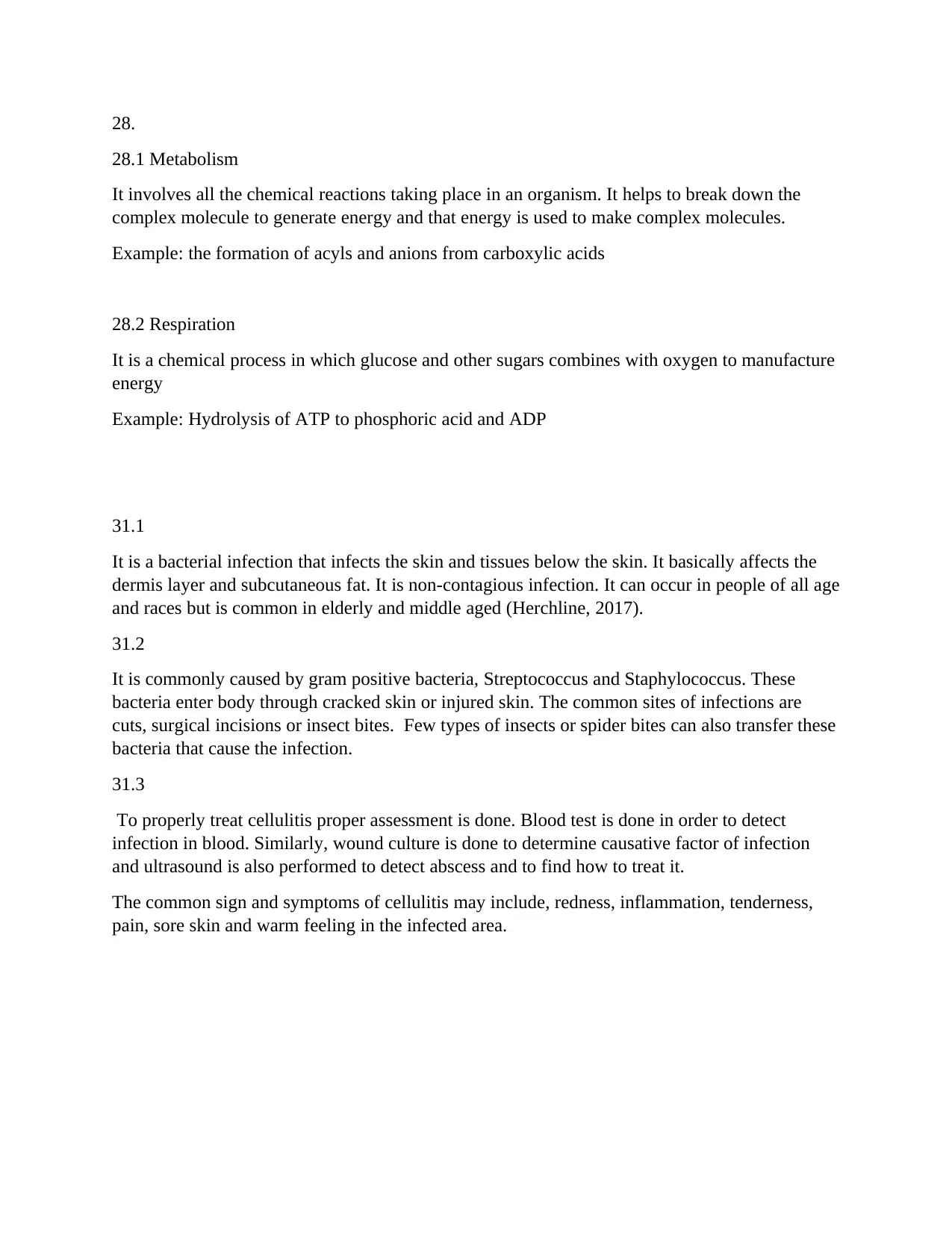
28.
28.1 Metabolism
It involves all the chemical reactions taking place in an organism. It helps to break down the
complex molecule to generate energy and that energy is used to make complex molecules.
Example: the formation of acyls and anions from carboxylic acids
28.2 Respiration
It is a chemical process in which glucose and other sugars combines with oxygen to manufacture
energy
Example: Hydrolysis of ATP to phosphoric acid and ADP
31.1
It is a bacterial infection that infects the skin and tissues below the skin. It basically affects the
dermis layer and subcutaneous fat. It is non-contagious infection. It can occur in people of all age
and races but is common in elderly and middle aged (Herchline, 2017).
31.2
It is commonly caused by gram positive bacteria, Streptococcus and Staphylococcus. These
bacteria enter body through cracked skin or injured skin. The common sites of infections are
cuts, surgical incisions or insect bites. Few types of insects or spider bites can also transfer these
bacteria that cause the infection.
31.3
To properly treat cellulitis proper assessment is done. Blood test is done in order to detect
infection in blood. Similarly, wound culture is done to determine causative factor of infection
and ultrasound is also performed to detect abscess and to find how to treat it.
The common sign and symptoms of cellulitis may include, redness, inflammation, tenderness,
pain, sore skin and warm feeling in the infected area.
28.1 Metabolism
It involves all the chemical reactions taking place in an organism. It helps to break down the
complex molecule to generate energy and that energy is used to make complex molecules.
Example: the formation of acyls and anions from carboxylic acids
28.2 Respiration
It is a chemical process in which glucose and other sugars combines with oxygen to manufacture
energy
Example: Hydrolysis of ATP to phosphoric acid and ADP
31.1
It is a bacterial infection that infects the skin and tissues below the skin. It basically affects the
dermis layer and subcutaneous fat. It is non-contagious infection. It can occur in people of all age
and races but is common in elderly and middle aged (Herchline, 2017).
31.2
It is commonly caused by gram positive bacteria, Streptococcus and Staphylococcus. These
bacteria enter body through cracked skin or injured skin. The common sites of infections are
cuts, surgical incisions or insect bites. Few types of insects or spider bites can also transfer these
bacteria that cause the infection.
31.3
To properly treat cellulitis proper assessment is done. Blood test is done in order to detect
infection in blood. Similarly, wound culture is done to determine causative factor of infection
and ultrasound is also performed to detect abscess and to find how to treat it.
The common sign and symptoms of cellulitis may include, redness, inflammation, tenderness,
pain, sore skin and warm feeling in the infected area.
Paraphrase This Document
Need a fresh take? Get an instant paraphrase of this document with our AI Paraphraser
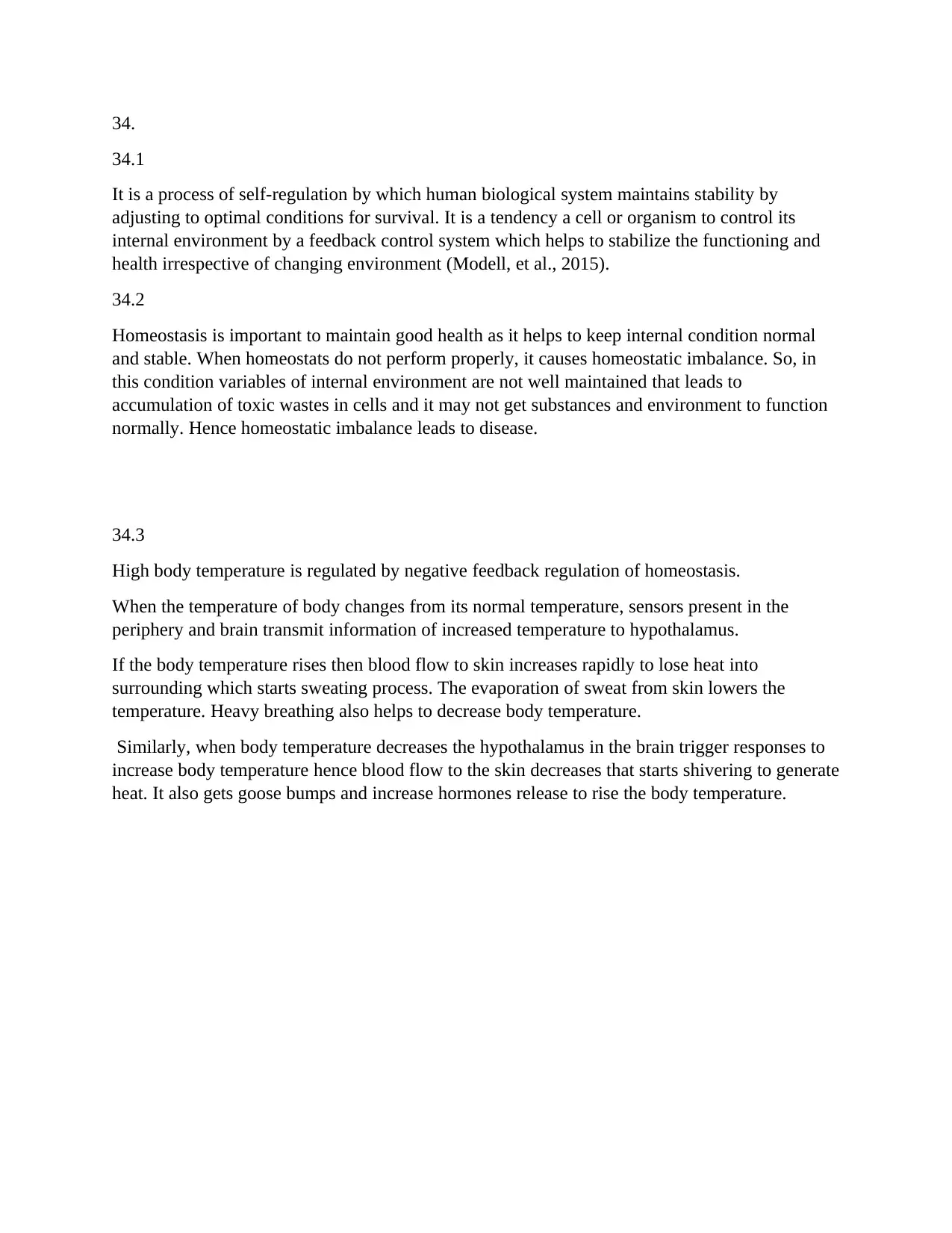
34.
34.1
It is a process of self-regulation by which human biological system maintains stability by
adjusting to optimal conditions for survival. It is a tendency a cell or organism to control its
internal environment by a feedback control system which helps to stabilize the functioning and
health irrespective of changing environment (Modell, et al., 2015).
34.2
Homeostasis is important to maintain good health as it helps to keep internal condition normal
and stable. When homeostats do not perform properly, it causes homeostatic imbalance. So, in
this condition variables of internal environment are not well maintained that leads to
accumulation of toxic wastes in cells and it may not get substances and environment to function
normally. Hence homeostatic imbalance leads to disease.
34.3
High body temperature is regulated by negative feedback regulation of homeostasis.
When the temperature of body changes from its normal temperature, sensors present in the
periphery and brain transmit information of increased temperature to hypothalamus.
If the body temperature rises then blood flow to skin increases rapidly to lose heat into
surrounding which starts sweating process. The evaporation of sweat from skin lowers the
temperature. Heavy breathing also helps to decrease body temperature.
Similarly, when body temperature decreases the hypothalamus in the brain trigger responses to
increase body temperature hence blood flow to the skin decreases that starts shivering to generate
heat. It also gets goose bumps and increase hormones release to rise the body temperature.
34.1
It is a process of self-regulation by which human biological system maintains stability by
adjusting to optimal conditions for survival. It is a tendency a cell or organism to control its
internal environment by a feedback control system which helps to stabilize the functioning and
health irrespective of changing environment (Modell, et al., 2015).
34.2
Homeostasis is important to maintain good health as it helps to keep internal condition normal
and stable. When homeostats do not perform properly, it causes homeostatic imbalance. So, in
this condition variables of internal environment are not well maintained that leads to
accumulation of toxic wastes in cells and it may not get substances and environment to function
normally. Hence homeostatic imbalance leads to disease.
34.3
High body temperature is regulated by negative feedback regulation of homeostasis.
When the temperature of body changes from its normal temperature, sensors present in the
periphery and brain transmit information of increased temperature to hypothalamus.
If the body temperature rises then blood flow to skin increases rapidly to lose heat into
surrounding which starts sweating process. The evaporation of sweat from skin lowers the
temperature. Heavy breathing also helps to decrease body temperature.
Similarly, when body temperature decreases the hypothalamus in the brain trigger responses to
increase body temperature hence blood flow to the skin decreases that starts shivering to generate
heat. It also gets goose bumps and increase hormones release to rise the body temperature.
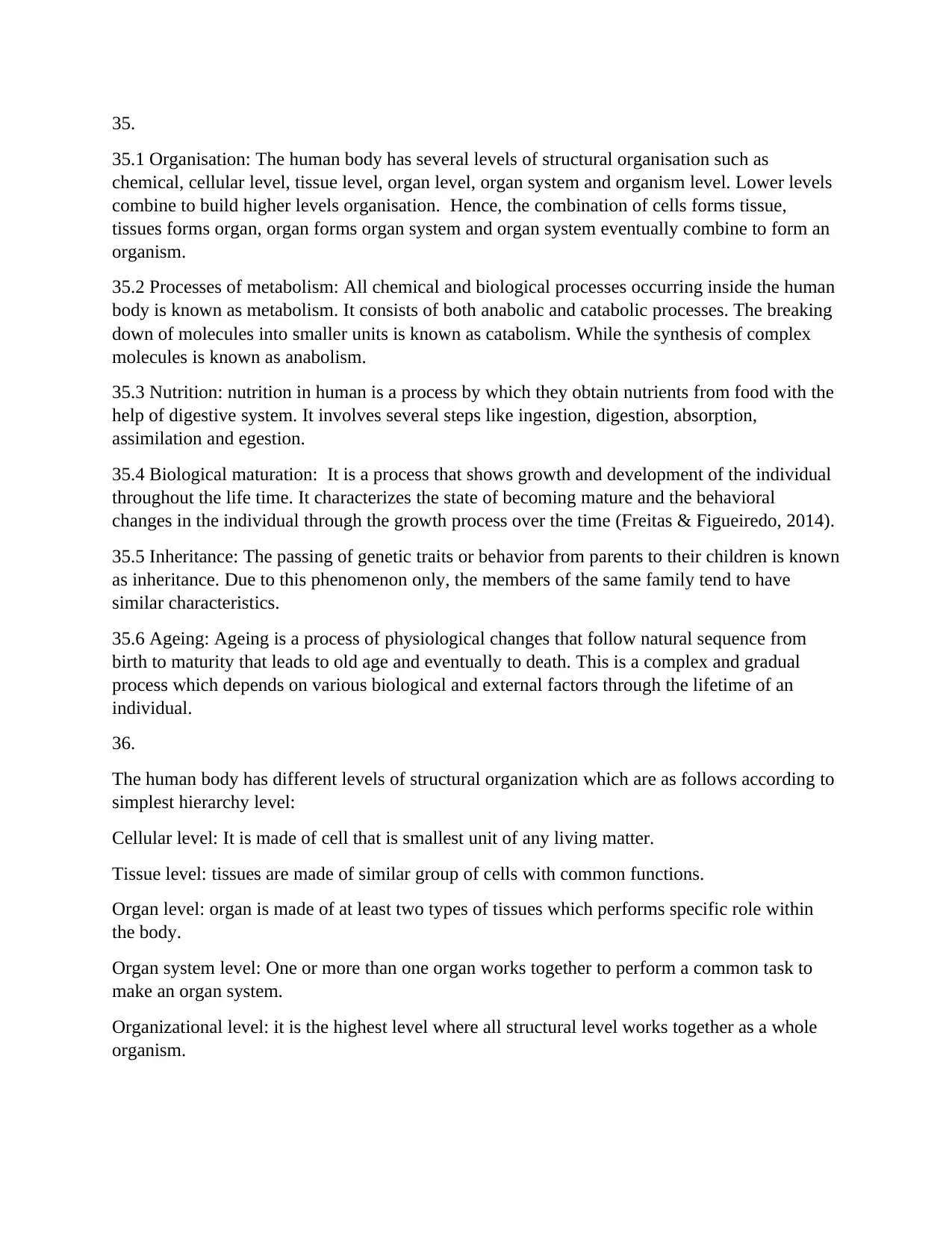
35.
35.1 Organisation: The human body has several levels of structural organisation such as
chemical, cellular level, tissue level, organ level, organ system and organism level. Lower levels
combine to build higher levels organisation. Hence, the combination of cells forms tissue,
tissues forms organ, organ forms organ system and organ system eventually combine to form an
organism.
35.2 Processes of metabolism: All chemical and biological processes occurring inside the human
body is known as metabolism. It consists of both anabolic and catabolic processes. The breaking
down of molecules into smaller units is known as catabolism. While the synthesis of complex
molecules is known as anabolism.
35.3 Nutrition: nutrition in human is a process by which they obtain nutrients from food with the
help of digestive system. It involves several steps like ingestion, digestion, absorption,
assimilation and egestion.
35.4 Biological maturation: It is a process that shows growth and development of the individual
throughout the life time. It characterizes the state of becoming mature and the behavioral
changes in the individual through the growth process over the time (Freitas & Figueiredo, 2014).
35.5 Inheritance: The passing of genetic traits or behavior from parents to their children is known
as inheritance. Due to this phenomenon only, the members of the same family tend to have
similar characteristics.
35.6 Ageing: Ageing is a process of physiological changes that follow natural sequence from
birth to maturity that leads to old age and eventually to death. This is a complex and gradual
process which depends on various biological and external factors through the lifetime of an
individual.
36.
The human body has different levels of structural organization which are as follows according to
simplest hierarchy level:
Cellular level: It is made of cell that is smallest unit of any living matter.
Tissue level: tissues are made of similar group of cells with common functions.
Organ level: organ is made of at least two types of tissues which performs specific role within
the body.
Organ system level: One or more than one organ works together to perform a common task to
make an organ system.
Organizational level: it is the highest level where all structural level works together as a whole
organism.
35.1 Organisation: The human body has several levels of structural organisation such as
chemical, cellular level, tissue level, organ level, organ system and organism level. Lower levels
combine to build higher levels organisation. Hence, the combination of cells forms tissue,
tissues forms organ, organ forms organ system and organ system eventually combine to form an
organism.
35.2 Processes of metabolism: All chemical and biological processes occurring inside the human
body is known as metabolism. It consists of both anabolic and catabolic processes. The breaking
down of molecules into smaller units is known as catabolism. While the synthesis of complex
molecules is known as anabolism.
35.3 Nutrition: nutrition in human is a process by which they obtain nutrients from food with the
help of digestive system. It involves several steps like ingestion, digestion, absorption,
assimilation and egestion.
35.4 Biological maturation: It is a process that shows growth and development of the individual
throughout the life time. It characterizes the state of becoming mature and the behavioral
changes in the individual through the growth process over the time (Freitas & Figueiredo, 2014).
35.5 Inheritance: The passing of genetic traits or behavior from parents to their children is known
as inheritance. Due to this phenomenon only, the members of the same family tend to have
similar characteristics.
35.6 Ageing: Ageing is a process of physiological changes that follow natural sequence from
birth to maturity that leads to old age and eventually to death. This is a complex and gradual
process which depends on various biological and external factors through the lifetime of an
individual.
36.
The human body has different levels of structural organization which are as follows according to
simplest hierarchy level:
Cellular level: It is made of cell that is smallest unit of any living matter.
Tissue level: tissues are made of similar group of cells with common functions.
Organ level: organ is made of at least two types of tissues which performs specific role within
the body.
Organ system level: One or more than one organ works together to perform a common task to
make an organ system.
Organizational level: it is the highest level where all structural level works together as a whole
organism.
⊘ This is a preview!⊘
Do you want full access?
Subscribe today to unlock all pages.

Trusted by 1+ million students worldwide
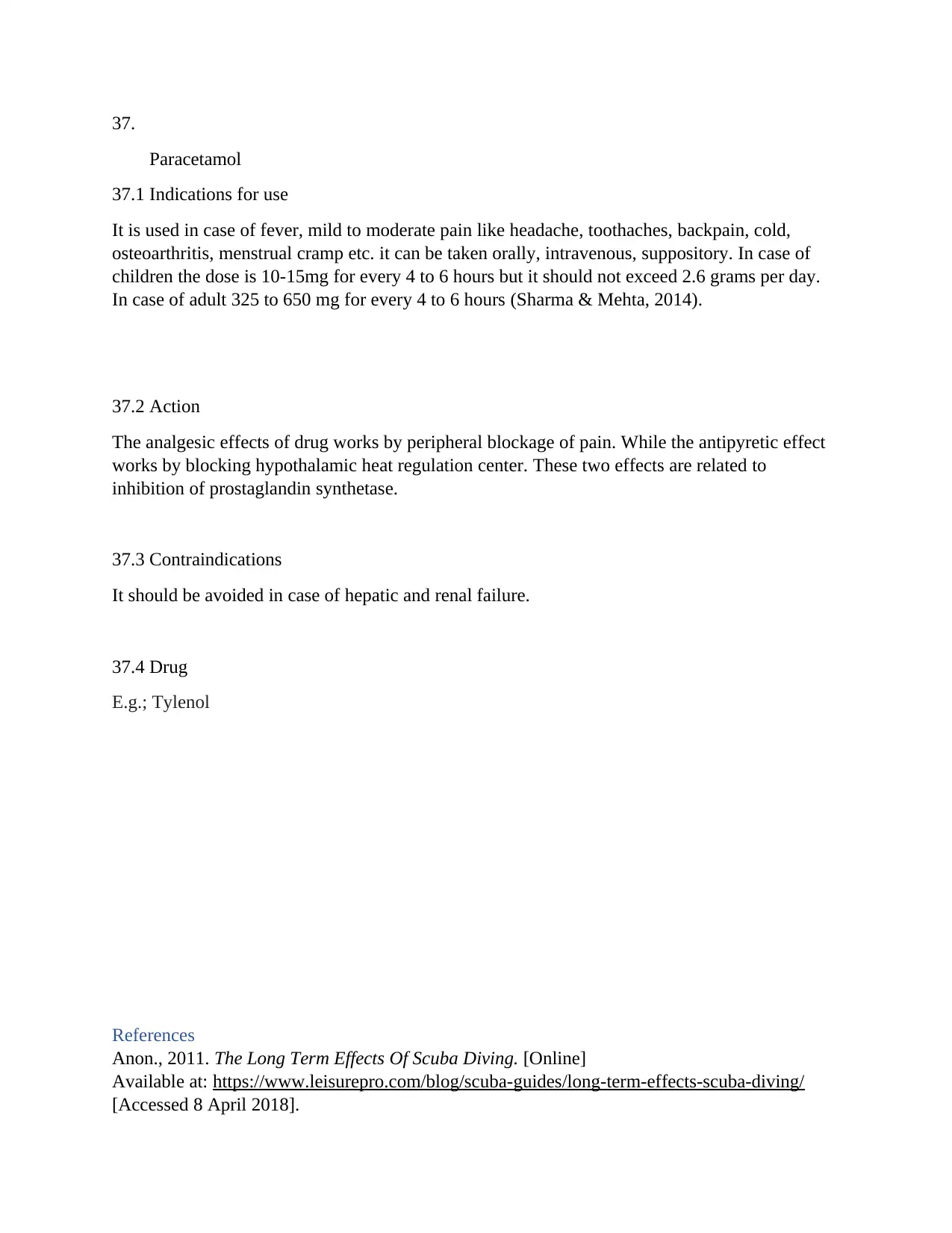
37.
Paracetamol
37.1 Indications for use
It is used in case of fever, mild to moderate pain like headache, toothaches, backpain, cold,
osteoarthritis, menstrual cramp etc. it can be taken orally, intravenous, suppository. In case of
children the dose is 10-15mg for every 4 to 6 hours but it should not exceed 2.6 grams per day.
In case of adult 325 to 650 mg for every 4 to 6 hours (Sharma & Mehta, 2014).
37.2 Action
The analgesic effects of drug works by peripheral blockage of pain. While the antipyretic effect
works by blocking hypothalamic heat regulation center. These two effects are related to
inhibition of prostaglandin synthetase.
37.3 Contraindications
It should be avoided in case of hepatic and renal failure.
37.4 Drug
E.g.; Tylenol
References
Anon., 2011. The Long Term Effects Of Scuba Diving. [Online]
Available at: https://www.leisurepro.com/blog/scuba-guides/long-term-effects-scuba-diving/
[Accessed 8 April 2018].
Paracetamol
37.1 Indications for use
It is used in case of fever, mild to moderate pain like headache, toothaches, backpain, cold,
osteoarthritis, menstrual cramp etc. it can be taken orally, intravenous, suppository. In case of
children the dose is 10-15mg for every 4 to 6 hours but it should not exceed 2.6 grams per day.
In case of adult 325 to 650 mg for every 4 to 6 hours (Sharma & Mehta, 2014).
37.2 Action
The analgesic effects of drug works by peripheral blockage of pain. While the antipyretic effect
works by blocking hypothalamic heat regulation center. These two effects are related to
inhibition of prostaglandin synthetase.
37.3 Contraindications
It should be avoided in case of hepatic and renal failure.
37.4 Drug
E.g.; Tylenol
References
Anon., 2011. The Long Term Effects Of Scuba Diving. [Online]
Available at: https://www.leisurepro.com/blog/scuba-guides/long-term-effects-scuba-diving/
[Accessed 8 April 2018].
Paraphrase This Document
Need a fresh take? Get an instant paraphrase of this document with our AI Paraphraser
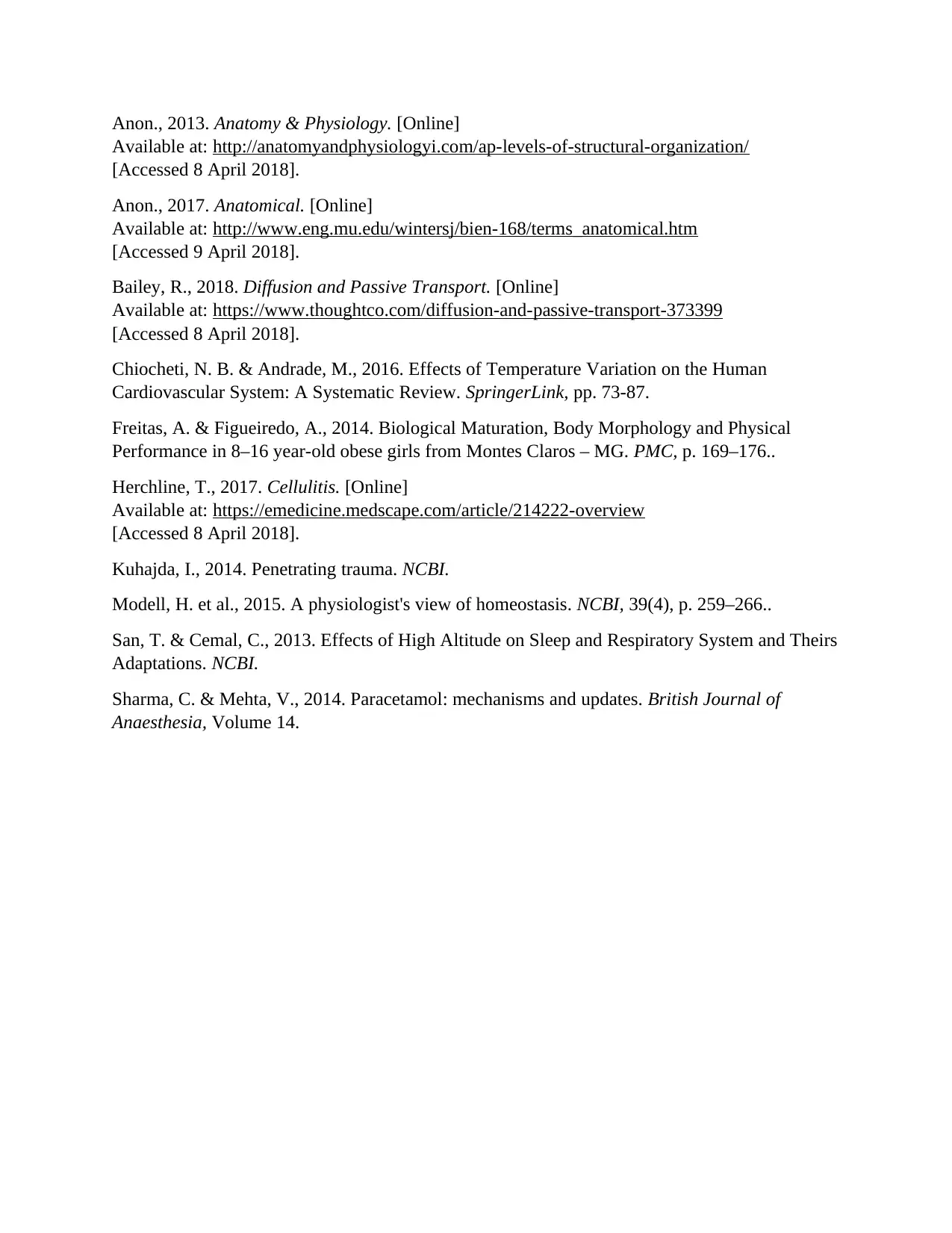
Anon., 2013. Anatomy & Physiology. [Online]
Available at: http://anatomyandphysiologyi.com/ap-levels-of-structural-organization/
[Accessed 8 April 2018].
Anon., 2017. Anatomical. [Online]
Available at: http://www.eng.mu.edu/wintersj/bien-168/terms_anatomical.htm
[Accessed 9 April 2018].
Bailey, R., 2018. Diffusion and Passive Transport. [Online]
Available at: https://www.thoughtco.com/diffusion-and-passive-transport-373399
[Accessed 8 April 2018].
Chiocheti, N. B. & Andrade, M., 2016. Effects of Temperature Variation on the Human
Cardiovascular System: A Systematic Review. SpringerLink, pp. 73-87.
Freitas, A. & Figueiredo, A., 2014. Biological Maturation, Body Morphology and Physical
Performance in 8–16 year-old obese girls from Montes Claros – MG. PMC, p. 169–176..
Herchline, T., 2017. Cellulitis. [Online]
Available at: https://emedicine.medscape.com/article/214222-overview
[Accessed 8 April 2018].
Kuhajda, I., 2014. Penetrating trauma. NCBI.
Modell, H. et al., 2015. A physiologist's view of homeostasis. NCBI, 39(4), p. 259–266..
San, T. & Cemal, C., 2013. Effects of High Altitude on Sleep and Respiratory System and Theirs
Adaptations. NCBI.
Sharma, C. & Mehta, V., 2014. Paracetamol: mechanisms and updates. British Journal of
Anaesthesia, Volume 14.
Available at: http://anatomyandphysiologyi.com/ap-levels-of-structural-organization/
[Accessed 8 April 2018].
Anon., 2017. Anatomical. [Online]
Available at: http://www.eng.mu.edu/wintersj/bien-168/terms_anatomical.htm
[Accessed 9 April 2018].
Bailey, R., 2018. Diffusion and Passive Transport. [Online]
Available at: https://www.thoughtco.com/diffusion-and-passive-transport-373399
[Accessed 8 April 2018].
Chiocheti, N. B. & Andrade, M., 2016. Effects of Temperature Variation on the Human
Cardiovascular System: A Systematic Review. SpringerLink, pp. 73-87.
Freitas, A. & Figueiredo, A., 2014. Biological Maturation, Body Morphology and Physical
Performance in 8–16 year-old obese girls from Montes Claros – MG. PMC, p. 169–176..
Herchline, T., 2017. Cellulitis. [Online]
Available at: https://emedicine.medscape.com/article/214222-overview
[Accessed 8 April 2018].
Kuhajda, I., 2014. Penetrating trauma. NCBI.
Modell, H. et al., 2015. A physiologist's view of homeostasis. NCBI, 39(4), p. 259–266..
San, T. & Cemal, C., 2013. Effects of High Altitude on Sleep and Respiratory System and Theirs
Adaptations. NCBI.
Sharma, C. & Mehta, V., 2014. Paracetamol: mechanisms and updates. British Journal of
Anaesthesia, Volume 14.
1 out of 8
Related Documents
Your All-in-One AI-Powered Toolkit for Academic Success.
+13062052269
info@desklib.com
Available 24*7 on WhatsApp / Email
![[object Object]](/_next/static/media/star-bottom.7253800d.svg)
Unlock your academic potential
Copyright © 2020–2025 A2Z Services. All Rights Reserved. Developed and managed by ZUCOL.



